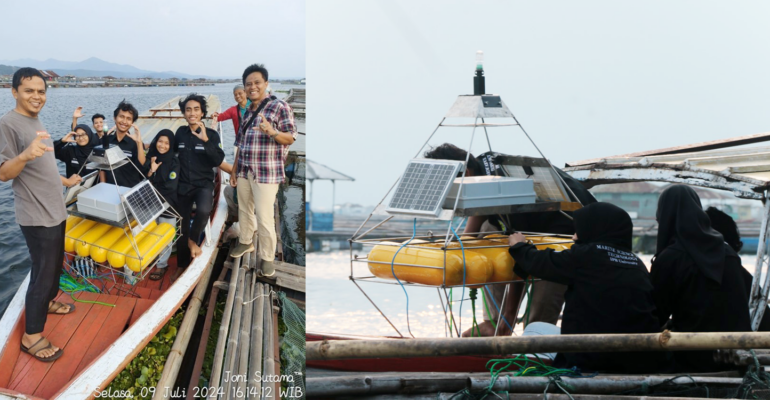Cool! IPB University Students Develop U-Buoy, an Early Warning Device to Prevent Mass Fish Deaths

Recently, the extreme weather has significantly impacted the fishing industry. An example is the mass fish deaths in Cirata Lake, West Java, caused by the upwelling process, where water masses move vertically from the lower layers to the surface. This phenomenon leads to fish poisoning and death.
Recognizing this problem, students from the Marine Science and Technology Study Program, Faculty of Fisheries and Marine Sciences (FPIK), IPB University, have created an instrument named U-Buoy. U-Buoy is an innovative solution to address the recurring issue of mass fish deaths caused by upwelling.
“U-Buoy is designed to be an early warning system that can detect upwelling events. This instrument is equipped with sensors that monitor air temperature, surface water temperature, and bottom water temperature in real-time,” explained Rizkian, the head of the U-Buoy development team.
He added that this data is crucial for understanding temperature variations and their relationship to conditions suitable for fish farming, aquatic life, and processes such as eutrophication, which is the excessive enrichment of nutrients in water bodies.
Mass fish deaths often occur due to undetected changes in environmental conditions. According to Rizkian, the main advantage of U-Buoy lies in its ability to provide early warnings about extreme environmental conditions that could potentially trigger mass fish deaths.
“This allows fishery entrepreneurs to take quick and effective actions before mass fish deaths occur, thereby minimizing economic losses,” he elaborated.
U-Buoy was developed by a group of IPB University students from the Student Creativity Program in Innovative Works (PKM KI), namely Rizkian Wahid Saputra, Iffa Purnama, Nabilla Aishi, and Tito Dzullyardana. The development of U-Buoy also involved guidance and supervision from Muhammad Iqbal, SPi, MSi.
“This instrument continuously monitors changes in air temperature, surface water temperature, and bottom water temperature. This allows us to provide early warnings about extreme environmental conditions and take action before mass fish deaths occur,” emphasized Rizkian.
Meanwhile, Muhammad Iqbal stated, “This innovation is interesting because, so far, fish farmers in Cirata Lake only perform occasional measurements to depict the dynamic water conditions. This results in inaccuracies and delays in taking action, ultimately causing significant losses.”
A similar sentiment was expressed by Asep Guntara, a fish farmer in Cirata Lake who facilitated the testing and implementation of the U-Buoy instrument. Asep mentioned that this instrument will greatly assist fish farmers in avoiding the dangers of upwelling, which occurs almost every year and causes substantial losses for farmers like him.
It is hoped that this innovation will effectively minimize the risk of mass fish deaths and the losses experienced by fish farmers in Cirata Lake. Besides benefiting the sustainability of fish farming, U-Buoy will also contribute to efforts to preserve aquatic environments. (*/Rz) (IAAS/RUM)



